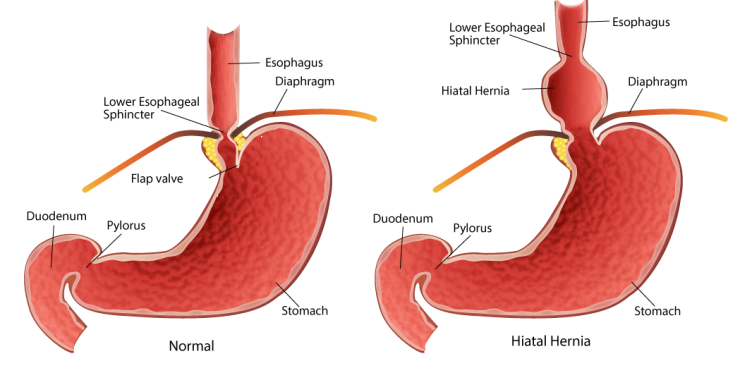

A hiatal hernia is an anatomical abnormality in which part of the stomach protrudes through the diaphragm and up into the chest. Although hiatal hernias are present in approximately 15% of the population, they are associated with symptoms in only a minority of those afflicted.
Normally, the esophagus or food tube passes down through the chest, crosses the diaphragm, and enters the abdomen through a hole in the diaphragm called the esophageal hiatus. Just below the diaphragm, the esophagus joins the stomach. In individuals with hiatal hernias, the opening of the esophageal hiatus (hiatal opening) is larger than normal, and a portion of the upper stomach slips up or passes (herniates) through the hiatus and into the chest. Although hiatal hernias are occasionally seen in infants where they probably have been present from birth, most hiatal hernias in adults are believed to have developed over many years.
It is thought that hiatal hernias are caused by a larger-than-normal esophageal hiatus, the opening in the diaphragm through which the esophagus passes from the chest into the abdomen; as a result of the large opening, part of the stomach "slips" into the chest. Other potentially contributing factors include:
1. A permanent shortening of the esophagus (perhaps caused by inflammation and scarring from the reflux or regurgitation of stomach acid) which pulls the stomach up.
2. An abnormally loose attachment of the esophagus to the diaphragm which allows the esophagus and stomach to slip upwards.
The vast majority of hiatal hernias are of the sliding type, and most of them are not associated with symptoms. The larger the hernia, the more likely it is to cause symptoms. When sliding hiatal hernias produce symptoms, they almost always are those of gastroesophageal reflux disease (GERD) or its complications. This occurs because the formation of the hernia often interferes with the barrier (lower esophageal sphincter) which prevents acid from refluxing from the stomach into the esophagus. Additionally, it is known that patients with GERD are much more likely to have a hiatal hernia than individuals not afflicted by GERD. Thus, it is clear that hiatal hernias contribute to GERD. However, it is not clear if hiatal hernias alone can result in GERD. Since GERD may occur in the absence of a hiatal hernia, factors other than the presence of a hernia can cause GERD.
heartburn
regurgitation
nausea
Treatment of large para-esophageal hernias causing symptoms requires surgery. During surgery, the stomach is pulled down into the abdomen, the esophageal hiatus is made smaller, and the esophagus is attached firmly to the diaphragm. This procedure restores the normal anatomy.
Since sliding hiatal hernias rarely cause problems themselves but rather contribute to acid reflux, the treatment for patients with hiatal hernias is usually the same as for the associated GERD. If the GERD is severe, complicated, or unresponsive to reasonable doses of medications, surgery often is performed. At the time of surgery, the hiatal hernia is eliminated in a manner similar to the repair of para-esophageal hernias. However, in addition, part of the upper stomach is wrapped around the lower sphincter to augment the pressure at the sphincter and further prevent acid reflux.
